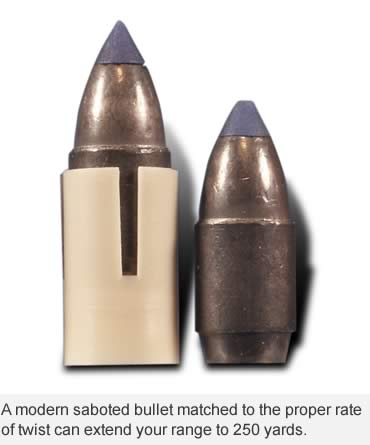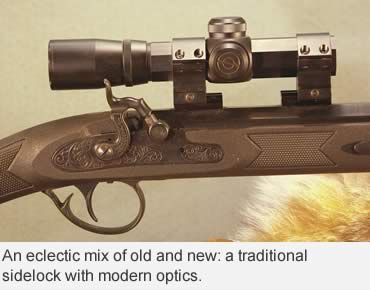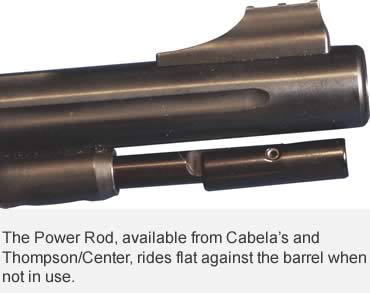By Ralph M. Lermayer
Voodoo ballistics and other misconceptions still abound in blackpowder shooting.
Photo: This double barrel rifle from Traditions provides the fastest second shot possible with a muzzleloading rifle. It’s also deadly accurate with the right load.
Prior to the 1980s, hunting with muzzleloaders was confined to a small cadre of traditionalists, history buffs and competitors, myself included. For us, acquiring a pristine, original, shootable flintlock was like stumbling upon the Holy Grail. We ran around with powder horns and fur hats, preaching the virtues of oddball things like cow’s knees, English flints and wasp’s nest wadding. We sneered at any hunter who used a modern gun.
Those of us who loaded patched round balls instead of conical bullets were forced to hunt hard, get close and make that one shot count. We had to pass up a lot of shots that were duck soup for centerfires.
Because of our self-imposed limitations, the states took pity on us and gave us a very liberal hunting season. When we did drop a hammer, we usually made meat — that is, if the darn thing went off.
Those same liberal seasons implemented in deer-rich states across the country eventually brought about the demise of the once-large fraternity of buckskinners. Hardcore hunters sought ways to make the muzzleloaders hit harder, shoot farther, go bang every time and pack a scope.
Blackpowder hunting changed forever when the first of the modern inlines came onto the scene in the mid-1980s. While a few still hang on to the old ways, many of us also welcomed the new.
The chaotic transition brought with it many myths, some carried over from the flinter days and others sour grapes from the traditionalists.
There’s no voodoo ballistics in muzzleloading. Whichever side of the line you’re on, separating the truth from fiction will help you “make meat.”
 Myth: More Powder Equals More Punch — Not true, and here’s why. Nitrocellulose powder (modern gunpowder) explodes. Blackpowder burns, and does so slowly compared to modern powder.
Myth: More Powder Equals More Punch — Not true, and here’s why. Nitrocellulose powder (modern gunpowder) explodes. Blackpowder burns, and does so slowly compared to modern powder.
While blackpowder calibers run the gamut from 32 to 72 bore, it is the half-incher, .50 caliber, that dominates the market.
Most modern .50-caliber barrels are about 24 inches long. Powder in the breech starts burning the second you ignite it, and as long as the barrel is semi-sealed with a bullet, the stuff burns thoroughly. Any powder still burning after the bullet leaves the bore burns incompletely, leaving big chunks of crud in the bore. This wasted powder does nothing for the bullet.
With a 300-grain bullet in an average-length barrel, 110 and 120 grains of rifle-grade (FFg) powder is usually most efficient. That load quits burning about the time the bullet leaves the bore, which translates to the best accuracy, sharpest report and cleanest barrel. It is the perfect load for a modern .50-caliber inline rifle. Two Pyrodex Triple Seven pellets deliver just that. Pick a good bullet, use that load, and you’ll get all your rifle has to deliver with no grief.
Myth: Shotgun primers give more velocity than musket caps, No. 11 caps, etc. — Not so. As stated above, blackpowder and its substitutes burn, and do so the same however you ignite them. It doesn’t matter. What the 209 shotgun primers do well is send a blast of fire through the tiny .028-inch hole into the breech, blowing by crud that might otherwise hinder ignition. A flintlock kept clean will ignite as well as a 209. To prove it, Sam Fadala once won a bet that he could get his flinter to go off 30 times without a misfire. He quit at 30, but could have gone on.
Myth: New powders don’t need cleaning. — Hogwash. I don’t care what powder you shoot, conventional or substitute, put your gun away without cleaning it for more than a few days and you will be welcomed with a ruinous, rusting mess when you get to it. Blackpowder substitutes like Pyrodex buy you some time, but they still need to be cleaned.
Fact: Cleaning a blackpowder rifle is messy. — Yeah, and stinky, too, but it’s much easier to get a blackpowder rifle totally clean than a centerfire. Simple water, nothing else needed, removes every trace of blackpowder fouling. Pull the plug or nipple, swab it out with water until clean, re-oil and put it up —simple and fast, but absolutely necessary.
 Myth: Inlines shoot farther than primitive rifles. — Nonsense. It’s all about the barrel and the bullet. A flintlock with a 1-in-28 rate of twist will shoot as fast, far and as accurately as any inline ever designed if the powder load and bullet weight are the same.
Myth: Inlines shoot farther than primitive rifles. — Nonsense. It’s all about the barrel and the bullet. A flintlock with a 1-in-28 rate of twist will shoot as fast, far and as accurately as any inline ever designed if the powder load and bullet weight are the same.
A barrel is just a piece of steel with a hole in it. They all shoot the same with equivalent barrels, and it doesn’t matter how you light the powder — flint or cap, inline or sidelock. Older guns have slow twists for round balls or medium twists for conicals, and the modern inlines usually have a fast 1-in-28 twist for sabots.
Myth: Blackpowder rifles are short-range rigs. — It depends on what you shoot and what you call short range. A well-designed .45- or .50-caliber bullet leaving any barrel at about 2,000 fps (easy in most blackpowder rifles), is a pretty decent killer out to about 200 yards. Those are the same stats for a .45-70. American Bison were almost wiped out with that setup and lots of muzzleloaders, too. Beyond 200 yards, bullets drop pretty quickly, about like a .30-30.
I’ve taken a lot of game at the 200-yard mark with muzzleloaders. They key is an accurate rifle and the right bullet. Don’t even think of going over 75 yards with that ballistic gnome, the round ball.
Myth: Pellets are just a high-cost marketing ploy. — Blackpowder and its substitutes are pretty crude stuff. Pack in 105 grains or 96 grains instead of your 100-grain load, spill a bit during a reload, and you won’t be far out of your group. What will substantially change your point of impact is the pressure on the load. Pack it hard instead of soft when you load, and you’ll be all over the paper. It changes pressure. Remember, blackpowder burns. How tightly it’s packed influences the burn.
Pellets eliminate the variation in seating pressure. Drop them in, seat the bullet on top, and you get the same ride out of the chute every time. That directly affects accuracy, so stick with pellets.
 Myth: A Ramrod is a ramrod is a ramrod — About 10 years ago, an innovative ramrod appeared on the scene. The Power Rod has a folding T-handle that rides flat against the barrel when not in use.
Myth: A Ramrod is a ramrod is a ramrod — About 10 years ago, an innovative ramrod appeared on the scene. The Power Rod has a folding T-handle that rides flat against the barrel when not in use.
It’s hard to believe dozens of wars were fought with muzzleloaders, and no one came up with this ingenious device. Loading, cleaning, seating bullets in a dirty bore, anything you ask a ramrod to do is easier and done in half the time with this rod.
The Power Rod is available in a variety of lengths from Cabela’s. Thompson/Center also includes them on many of their great rifles. Get one for your rifle and save your old rod for the bench. You won’t ever go back.
Read Recent GunHunter Articles:
• Classic Styling is Everlasting: Jack O’Connor’s favorite Model 70s are great examples of timeless elegance in rifle design.
• Duh! It’s the Barrel: Factors to consider when buying or rebarreling a hunting gun.
This article was first printed in the July 2011 edition of Buckmasters GunHunter Magazine. Subscribe today to have GunHunter delivered to your home.